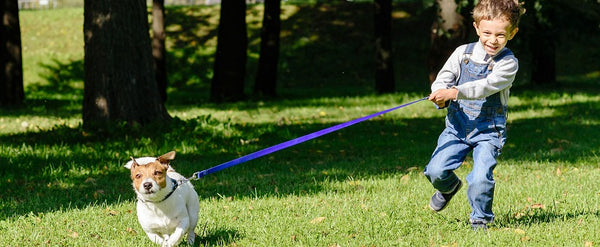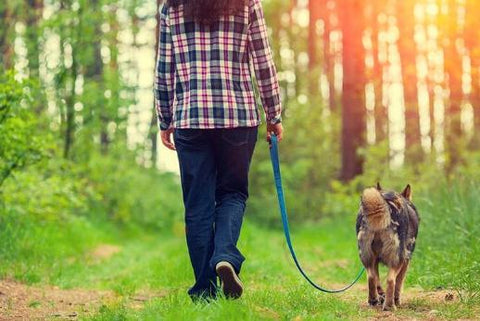Is your dog taking you for a walk? Why is your dog pulling so hard? How can you finally train your dog to walk on a loose leash? Go on reading, you will learn 1 or 2 ways to stop dog from pulling on the leash.

Why do dogs pull on leash?
That’s pretty simple. It is because they haven’t been trained how to walk on one. Dogs are excited by the environment and they really just want to go see everything. So we’re going to go over how to stop your dog from pulling on the leash.
Training Tools
- A four to six-foot dog leash or Lead. For mild pullers, you can choose front clip body harness, freedom no pulls body harness. For strong pullers, you will need a head harness.
- Healthy treats. Small bite-size pieces that you can easily access, because you may end up giving quite a bit.
- A clicker.

Tip Before You Start
- Regular Exercise
Regularly exercising to give them the freedom to run and be a dog is critically important for successful walking by. Allowing your dog to have the off-leash time where they can run around and take the edge off physically, you are setting yourself and your dog up to succeed for a better walk.
When you do go out, they won't have the pent-up energy, wanting to burst out. Walking is exercise, but if they're pulling, it's a double-ended sword. We want to exercise them, but if the dog is only getting structured walks as their main form of exercise, you will struggle with loose leash walking for a longer period of time.
- Avoid Busy Areas
Make it easy in the beginning, and try not to take your dog to bustling areas, where not only does your dog have to suppress the urge to pull, but also has to suppress the urge to go say hello to everyone, and not pull for every wonderful brand new scent there.
- Compromising Sniffing is important
Sniffing is a really important behavior for dogs to do. It's very natural. We have to take into account our dog's needs. This walk is not solely for the human, it is 50% for the dog. However, if your dog is sniffing and pulling you forwards, we can still train them.
They're allowed to sniff possibly when we allow them. We can give them a cue to go and sniff at every block or every half-block where we can stop and they have that complete range. At the same time, if they start pulling, we stop until they stop pulling. It's actually a negative punishment, the dog does not get what he or she wants if they're pulling.
Techniques for Better Walking

#1. The Clicker Method Proactive approach
This technique is focusing on rewarding good behavior and interrupting the dog before they can pull on the leash. What the click does is teach the dog that the behavior that they are doing at the moment, is good. When trained for long periods of time, the slowing down for the treat starts to become muscle memory, the dog will automatically start interrupting themselves because it pays off.
The click marks the good behavior, clicking for the dog walking on a slack. This will help using treats that hold their shape and don't crumble when touched, yet they should be smelly and enticing to the dog that you're working with.
For loose leash walking, you really should be using healthy treats, due to the fact that you may use quite a bit in the beginning. You can even use kibble mixed in with some smelly treats. Any treats that are semi-hard are the best to use for this training.
# 2. Stop & Go
This is the stop-and-go approach which is a reactive approach to training. This technique is focusing on taking away what the dog wants for undesirable behavior. We stop moving to communicate to the dog that “the behavior won't get you what you want”.
Once the dog loosens up on the slack, we move again. Communicating that when there is no tension you move forwards.

#3. Humane training equipment
Humane training equipment can definitely help, especially if you have a dog that pulls and pulls. A head halter or front clip body harness can give you those extra moments you need to pull training out.
However, using the equipment shouldn't be forever, they are used to help you with the difficulties during training.
A head harness is a self-correcting tool, that when the dog pulls, their head is turned away from the fun, so the dog learns not to pull.
The body harness does the same as the head harness but from the chest area, pulling their body sideways if they pull on the leash. It can be very beneficial for on and off pullers.
For strong pullers, you will go from a head harness and when they aren't pulling and you see that they're giving a slack leash, you will move to the body harness. When you see the dog isn't pulling on the body harness, you can start reintroducing the collar, or a back clip harness.
#4. Long Term Heeling Position is unfair and unnatural.
There's a huge misconception out there that your dog should be walking right beside you in a heel position for long periods of time. Dogs have natural instincts and need to be satiated.
The one big problem is you're forcing that dog to cope with so much visual stimuli and to suppress every single ounce of instinctual behavior and natural behavior to walk with you.
Stop the dog from distressing himself on a walk, your dog is going to be more reactive. Your dog can definitely become over stimulant and overwhelmed, and at the same time very frustrated because a lot of the time we do rely on our walks for the majority of our dogs’ exercise.
We don't necessarily always take our dogs to an off-leash park or an off-leash area where that dog actually has the ability to run free. So walk again should be 50/50. 50% is for the owner, 50% for the dog.
Remember there is a balance. Enough freedom to satiate the dog's needs, which is maybe once a day, and then one structured walk or two per day. You could even start with some freedom out of field for 15 minutes with a long line or in a park that allows off-leash, then you can go for a walk pulling into the structured training, then possibly off-leash again for some good behavior.
Remember, if your dog is pulling, they're learning loose leash. Walking takes months to a year to be 100% successful in all environments. Be patient and set your dog and yourself up to succeed. If you enjoyed it and would like to see more news, do not hesitate to visit Happy & Polly website on https://happyandpolly.com.

